| |
Prague - New Town (Nove Mesto)
Charles IV's most important decisions – the
founding of New Town of Prague, the founding of Prague University
and the building of Karlstejn Castle – were made at the very
beginning of the sovereign's reign, in 1348. The New
Town was planned to have three central open spaces – the Cattle
Market (now Charles Square), the Horse Market (now Wenceslas Square),
and the Hay Market (now Senovazny Square). The expensive and noble
New Town, with Wenceslas Square as its centre, is characterized
by elegance and style. Many significant companies have their offices
there and many political and cultural revolutions took place there,
especially in the 20th century.
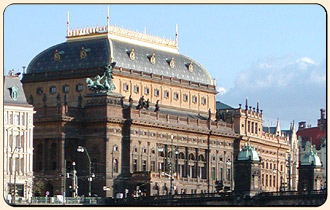
The National Theatre
This National Cultural Monument is of special significance
for the Czech nation. In the middle of the 18th century Prague
had no theatre that performed only in Czech. The Czech language
could be heard occasionally in some theatres, but mostly
plays were in German. In the rousing atmosphere of realization
of
a blooming national identity, collections were made all over
the country, with the slogan “The nation to itself”,
to build a Czech national theatre.
The National Theatre is a Neo-Renaissance building of 1868-1881,
built after plans by the architect J. Zitek and completed after
a fire by the architect J. Schulz in 1883. The theatre was
officially opened on 15th of June 1881, with the opera “Libuse” by
Bedrich Smetana.
The building burned entirely two months later.
However, two years following, you could hear “Libuse” once
again, in a theatre built with collected money. The New Stage of the National theatre, built in the 1970s
from Cuban marble and glass block is, even today, very controversial
from an architectural point of view. The building currently
houses the famous “Laterna Magica”. |
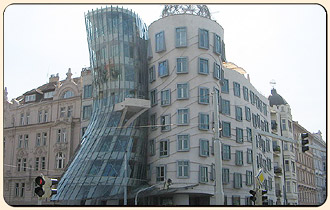
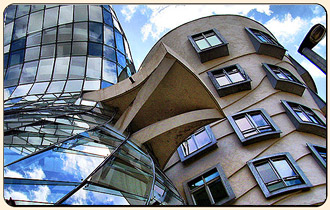
The Dancing House
It is called the dancing House, because its two towers bring
the dancers Ginger Rogers and Fred Astaire to mind. It was
build after the Velvet Revolution in 1989. The design of Vlado
Mulunic was co-authored by American architect Frank O. Gehry.
The Dancing House was the subject of numerous disputes between
experts and laymen alike. Finally, however, Prague accepted
the avant-garde design of the building, which gained the high
(American) Time Magazine award in the World Design category
in 1996. |
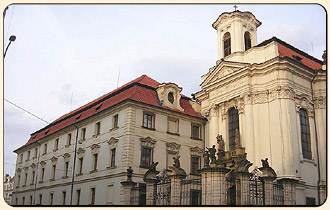
The Church of St. Cyrill and Methodius
A Baroque church built by K. I. Dientzenhofen in 1730 – 1736,
the church is tragically inscribed in the history of the Czechoslovak
Resistance movement of the Second World War. Czechoslovak parachutists,
who assassinated Reinhard Heydrich, the Deputy Reich Protector
of Bohemia, used the crypt of the church as a hiding place
in May, 1942. After long and furious fighting, on the 18th
of June, 1942, the resistance fighters were all killed. There
is a table bearing their names, commemorating those brave parachutists. |
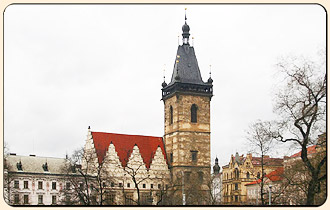
Charles Square
Originally called the Cattle Market, Charles Square is the
largest square in the Czech Republic. The Town Hall of the
New Town is situated on the square. The New Town was built
in a Gothic style. On 30th July, 1419, the first Prague defenestration
took place there. The Jesuits Baroque church, St. Ignatius,
dating from the 17th century, borders the square. |
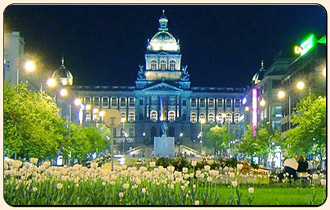
Wenceslas Square
Wenseslas Square consists of the main and largest boulevard,
a shopping centre and the centre of modern Prague, surrounded
by cinemas, office blocks, renowned hotels, restaurants and
cafés.
The square is 750 metres long and 60 metres wide.
It was called the House Market until 1848. It is presently
named after the equestrian memorial to Prince Wenceslas,
surrounded by statues of the Czech patron saints: St. Ludmila,
St. prokop,
St.Agnes and St. Adalbert, all of them by J. V. Myslbek.
Wenceslas Square played an important role in the history of
Prague in 1945, 1968, 1989 and, especially, on 28th October,
1918,
when
the Czechoslovak Republic was proclaimed there. The German
writer, Detlef of Liliencron, called Wenceslas Square “the
proudest boulevard of the world”. Across the top of the square is the imposing building of the
National Museum, designed by architect J.Schulz and built in
1885-1890 in a Neo-Renaissance style. Until 1875, the so-called
Horse Gate occupied this site. The National Museum is richly
decorated with sculptures and paintings by leading Czech 19th
century artists. |
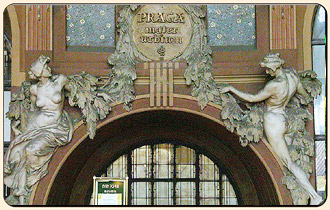
The Main Train Station (Wilson Train Station)
The station is an Art Nouveau building erected from 1901-1909
by V. Gregor, after a plan by the architect J. Fanta. You can
see there, the well-known Fanta´s café. The Main
Train Station is situated on Wilson Street, renamed after US
president Woodrow Wilson.
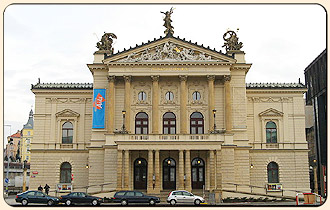
The State Opera
The State Opera is a Neo-Renaissance building. It was designed
by the architects F. Fellner and H. Helmer from Vienna. Already
in 1859, there was a wooden building on this site, which was
used only during the summer as a New Town Theatre. Originally,
the State Opera was a German theatre. The famous Czech composer,
Bedrich Smetana, was the director of the opera house until
1882. |
|
|











